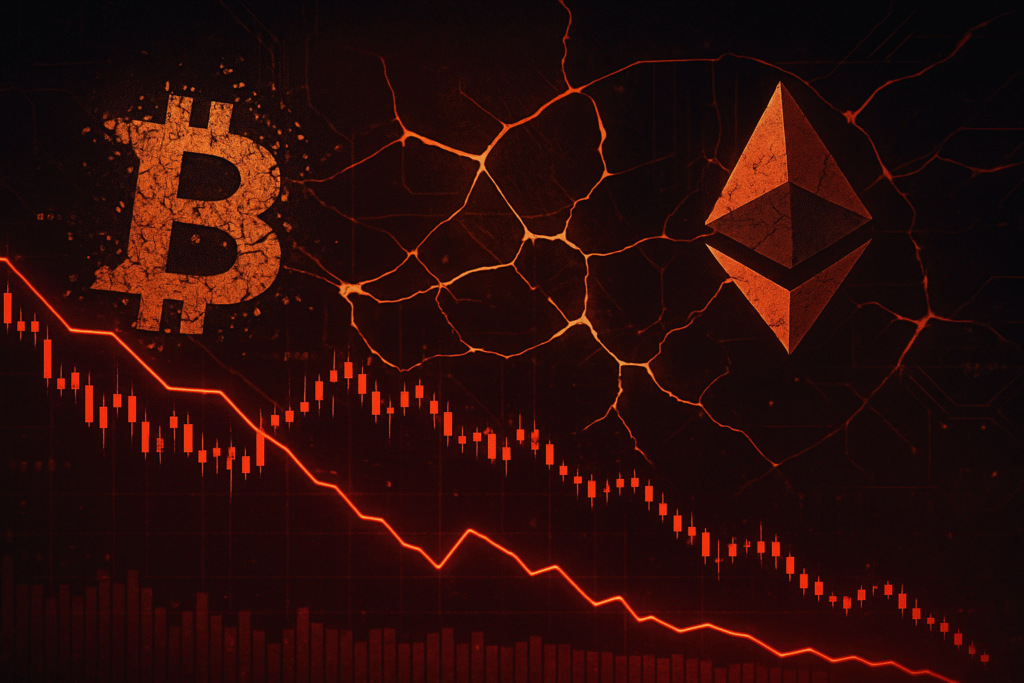
October 14, 2025 – The cryptocurrency market reeled from a seismic shock last weekend as escalating geopolitical tensions between the United States and China sent digital asset prices plummeting. On Friday, October 10, 2025, former US President Donald Trump announced plans to impose a drastic 100% tariff on Chinese imports, effective November 1, 2025, a move that reignited fears of a full-blown trade war. This declaration, reportedly in response to China's new restrictions on rare earth minerals and critical software exports, immediately triggered a widespread "risk-off" sentiment across global markets, with cryptocurrencies bearing a significant brunt of the fallout.
In the wake of the announcement, Bitcoin (BTC) plunged by as much as 11%, dropping from highs around $117,000 to lows touching $102,000. The broader crypto market experienced a staggering wipeout, with estimates of lost market capitalization ranging from $150 billion to over $550 billion in a matter of hours. This event served as a stark reminder of crypto's increasing susceptibility to macroeconomic forces and geopolitical strife, challenging its perceived status as a fully uncorrelated asset and highlighting its growing interconnectedness with traditional financial markets. The immediate aftermath saw panic selling, massive liquidations, and technical disruptions on major exchanges, underscoring the volatility inherent in the digital asset space during times of global uncertainty.
Market Impact and Price Action
The announcement of impending 100% tariffs on Chinese imports by former US President Donald Trump on Friday, October 10, 2025, sent immediate tremors through the cryptocurrency market, triggering one of the most significant single-day liquidation events in recent memory. Bitcoin (BTC) bore the brunt of the initial sell-off, plummeting from an intra-day high of approximately $117,000 to briefly touch lows around $102,000-$103,800, representing an 11% decline. This sharp correction liquidated billions in leveraged positions, with some reports indicating over $7 billion in positions sold off in less than an hour, and more than $19 billion in leveraged crypto positions wiped out across the market.
Beyond Bitcoin, the contagion spread rapidly to altcoins, with Ethereum (ETH), Solana (SOL), XRP, and BNB all experiencing double-digit percentage drops. Many smaller cap altcoins saw even more drastic declines, with some falling by 15-30% or even up to 90% in the ensuing chaos. The total cryptocurrency market capitalization, which had been hovering near multi-trillion dollar valuations, shed an estimated $150 billion to over $550 billion, depending on the reporting source and the timeframe considered, illustrating the sheer scale of capital flight from the digital asset space.
Trading volumes surged dramatically during the downturn, indicating a rush to exit positions. Liquidity on some decentralized exchanges (DEXs) and centralized platforms (CEXs) became strained, with major players like Binance (BNB) reporting "heavy market activity" leading to temporary disruptions and user complaints of frozen accounts and failed stop-loss orders. Technically, Bitcoin breached several key support levels, including the psychological $110,000 mark and critical moving averages, signaling a shift in market sentiment from bullish to distinctly bearish. Analysts are now closely watching the $100,000 level as a crucial psychological and technical support, with a break below potentially opening the door for further downside.
This event draws parallels to past instances where geopolitical events or macro-economic shocks, such as the initial COVID-19 market crash in March 2020 or previous trade war escalations, led to a flight from risk assets, including cryptocurrencies. While crypto has often been touted as a hedge against traditional financial instability, this latest downturn reinforces the growing correlation between digital assets and broader equity markets, particularly during periods of extreme fear. The scale of liquidations, however, marks this as a particularly brutal and swift market adjustment.
Community and Ecosystem Response
The crypto community's response to the tariff-induced market crash was a mix of panic, frustration, and a renewed debate over Bitcoin's (BTC) role as a safe-haven asset. On platforms like X (formerly Twitter) and Reddit, sentiment quickly soured, with hashtags like #CryptoCrash and #TariffWar trending. Many retail investors expressed dismay over rapid losses, particularly those with highly leveraged positions, as the cascading liquidations exacerbated the downturn. Screenshots of significant portfolio losses flooded social media, alongside calls for calm and discussions about "buying the dip" from more seasoned traders.
Crypto influencers and thought leaders offered varied perspectives. Some emphasized the inherent volatility of the market, advising long-term holders to "HODL" and view the dip as a buying opportunity, while others criticized the lack of decentralization in the face of macro events, questioning why a supposedly independent asset class was so heavily impacted by traditional political machinations. The disruption on major exchanges like Binance (BNB) also drew ire, with users reporting inability to execute trades or manage risk, leading to accusations of market manipulation or insufficient infrastructure.
The impact extended beyond spot markets. Decentralized Finance (DeFi) protocols saw a significant decrease in Total Value Locked (TVL) as users withdrew assets, anticipating further price declines. Lending protocols faced increased liquidation risks for undercollateralized positions, while some stablecoin pegs experienced minor fluctuations due to heightened trading activity and arbitrage opportunities. NFT projects, typically more resilient to short-term market fluctuations, also saw a noticeable drop in floor prices and trading volumes, reflecting the broader risk aversion. Web3 applications, though less directly impacted in their functionality, faced a chilling effect on new user adoption and investment sentiment as the ecosystem grappled with uncertainty.
What's Next for Crypto
The immediate outlook for the crypto market remains precarious, heavily contingent on the evolving geopolitical landscape between the US and China. Short-term implications suggest continued volatility as markets digest the full scope of the tariff threats and await potential retaliatory measures from Beijing. The sentiment remains "risk-off," meaning investors are likely to favor traditional safe-haven assets like gold and government bonds over cryptocurrencies in the coming weeks. Bitcoin's ability to hold the critical $100,000 support level will be a key determinant of its immediate trajectory, with a breach potentially signaling further downside to the $90,000-$95,000 range.
In the medium to long term, the implications are more complex. A prolonged US-China trade war could either continue to depress crypto prices due to global economic slowdown fears or, paradoxically, strengthen Bitcoin's (BTC) appeal as a decentralized alternative to fiat currencies susceptible to political maneuvering. Potential catalysts to watch include any de-escalation talks between the US and China, a clear response from Beijing regarding the tariffs, or the release of key macroeconomic data that could influence central bank policies. Further regulatory clarity from major economies could also provide a much-needed boost of confidence.
For projects and investors, strategic considerations include a renewed focus on robust risk management, particularly for those involved in leveraged trading. Projects might need to emphasize their fundamental value proposition and utility beyond speculative trading, while investors could consider diversifying portfolios and re-evaluating their exposure to highly correlated assets. The market may also see a flight to quality, with stronger, more established projects potentially outperforming weaker ones during sustained downturns. Possible scenarios range from a swift recovery if tensions ease, to a prolonged bear market if the trade war intensifies, or a gradual decoupling of crypto from traditional markets if its unique value proposition as a hedge against state-controlled finance gains traction. The latter, while optimistic, would require a significant shift in current market dynamics.
Bottom Line
The recent crypto market upheaval, triggered by the escalating US-China tariff war, serves as a critical juncture for investors and enthusiasts alike. The immediate takeaway is a stark reminder that even a nascent, decentralized asset class like cryptocurrency is not immune to the powerful currents of global geopolitics and macroeconomic forces. The 11% plunge in Bitcoin (BTC) and the estimated $150 billion (or more) wiped from the total market capitalization underscore the inherent volatility and the increasing correlation between digital assets and traditional risk markets during periods of stress.
The long-term significance of this event lies in its challenge to Bitcoin's (BTC) 'digital gold' narrative. While some proponents argue that continued geopolitical friction could eventually bolster Bitcoin's appeal as a truly independent asset, the immediate reaction saw capital flow out of crypto and into traditional safe havens. This suggests that for now, mainstream investors still view cryptocurrencies as risk assets. However, it also highlights the growing maturity of the market, where external events have a more pronounced and immediate impact.
Moving forward, key takeaways for crypto investors include the imperative for diligent risk management, particularly avoiding excessive leverage, and a critical re-evaluation of portfolio diversification strategies. Understanding the broader economic and political landscape will be as crucial as technical analysis. Important metrics to monitor include the rhetoric from US and Chinese officials, global trade data, and any changes in central bank monetary policies, which will all likely likely continue to exert significant influence on crypto prices. The period ahead will test the resilience of the crypto ecosystem and its ability to navigate a world increasingly shaped by geopolitical rivalry.
This article is for informational purposes only and does not constitute financial or investment advice. Cryptocurrency investments carry significant risk.






